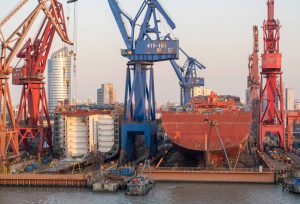Competition among both China and Korea is supremely tough for newbuildings. While China is actively taking orders, it has the capacity to undertake the projects – unlike its rival who is frantically gathering manpower to address the load, including hiring foreigners.
The interesting race continues
The growth in domestic and international orders has enabled many Chinese shipbuilders to expand and modernise their facilities. They are building new and modern yards, as well as expanding capacity at existing ones. Data from Clarkson Research Services showed in its recent report that Mediterranean Shipping Co (MSC) signed 14 TEU liquefied natural gas (LNG) capable boxships at Chinese yard New Times Shipbuilding. It signed a further 6 7,900 TEU units at South Korea’s Hyundai Heavy Industries (HHI). All units are due to be delivered in 2025. No price has been revealed for the Chinese vessels, while the Korean ones are said to be costing US$134.3m per unit.
A source added that these vessels would have MAN ME-GI engines and GTT’s Mark III Flex containment system. MSC was looking for 8 more of these dual-fuel LNG containerships and both K Shipbuilding and Samsung Heavy Industries (SHI) could build these them. Assuming both K Shipping and SSHI win the order, it is an official tie on the grand total at 14 units each for China and Korea.
MSC operates a fleet of more than 600 vessels, and recentlywelcomed its first LNG-powered containership, the MSC Washington – built by China’s Yangzijiang Shipbuilding. The shipping heavyweight is working on having LNG vessels to comply with net zero emissions goals. Despite the tight competition, both nations would still need to contend with volatile steel prices, or that of raw materials needed to make steel for yards. How the builders manoeuvre this will contribute to their score cards.






